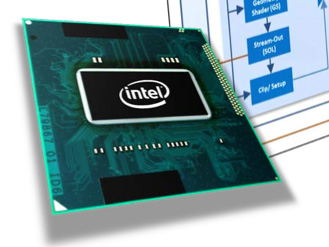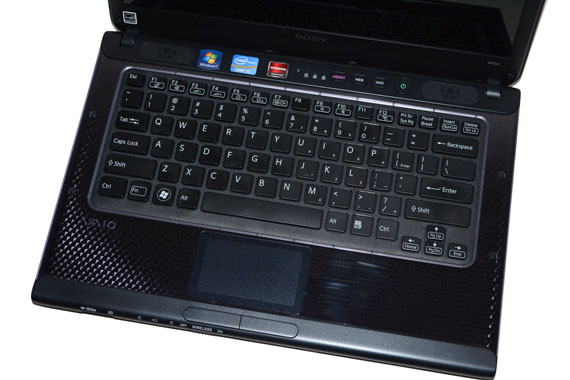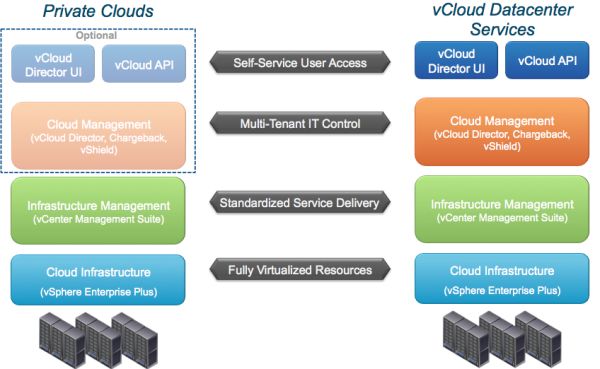Results 921 to 930 of 12096
Thread: Anandtech News
-
09-17-11, 01:10 AM #921
Anandtech: Intel's Ivy Bridge Architecture Exposed
Five years ago Intel announced its ambitious tick-tock release cadence. We were doubtful that Intel could pull off such an aggressive schedule but with the exception of missing a few months here or there tick-tock has been a success. On years marked by a tick Intel introduces a new manufacturing process, while tock years keep manufacturing process the same and introduce a new microprocessor architecture. To date we've had three tocks (Conroe, Nehalem, Sandy Bridge) and two ticks (Penryn, Westmere). Sampling by the end of this year and shipping in the first half of next year will be Intel's sixth tick: Ivy Bridge.
 Read on for our analysis of Intel's 2012 Core microarchitecture.
Read on for our analysis of Intel's 2012 Core microarchitecture.
More...
-
09-17-11, 01:20 AM #922
Anandtech: There Will Be Two 32nm Atom SoCs in 2012: Medfield and One Other
Intel did a good job of showing off what it promises to deliver with Medfield at IDF: a reasonably looking smartphone and tablet built around the platform. As a quick recap, Intel introduced Atom to the ultra mobile market with Menlow in 2008. Menlow was a three chip solution (CPU, NB, SB) built at 45nm. Moorestown came in 2010, integrating the North Bridge but still requiring a separate South Bridge. Most solutions in this space offer a single chip for the majority of the logic and interfaces. Medfield delivers exactly that. Built on Intel's 32nm process, Medfield finally integrates the CPU, North and South Bridges - putting it on par, from an integration standpoint, with offerings from TI and NVIDIA (Qualcomm still offers an integrated modem with its SoCs).
Intel has actually been relatively quiet about the specifics of a Medfield SoC. It's unclear whether there are one or two cores, with or without Hyper Threading. Even the GPU is somewhat unclear, although it's unlikely that it's something SGX 543MP2-class given Medfield's original launch target was sometime this year.
The goal of Medfield seems to have shifted to simply finding itself in a smartphone. We were supposed to see such a thing by the end of this year, but instead we've been told to expect it early in 2012. If Medfield is now aimed at simply showing up, what can Intel do to remain competitive in 2012?
Silvermont will be available in 2013, based on Intel's 22nm process. Between Medfield and it however will be another 32nm Atom design that has, until now, remained out of the public eye. We were first made aware of the design at IDF this week, however we weren't given any more details. If I had to guess, I'd say this 2nd 32nm Atom SoC would definitely be a dual-core solution (perhaps with HT enabled?) with an upgraded GPU core. Intel is playing its Atom strategy close to its chest until the first design win is announced.
The Google announcement at IDF was critical. This actually reminds me a lot of what happened to NVIDIA's Tegra 2 in 2010. Announced at CES 2010, Tegra 2 was plagued by design wins that never surfaced and work on OSes that never went anywhere. It was only after focusing exclusively on Android that NVIDIA was able to finally execute. Intel is at that stage now with Atom, now it's all up to execution and optimization.
More...
-
09-17-11, 08:30 AM #923
Anandtech: Portal Now Free Until Sept. 20
If you’ve yet to try Valve’s mind-bending first-person puzzler Portal, you now have no excuse. The original Portal is currently free on Steam until September 20th.
Valve was inspired by teachers who’ve worked Portal into their classrooms and wants to encourage other educators to do the same. “One of the biggest challenges in teaching science, technology, engineering, and math is capturing the students’ imaginations long enough for them to see all of the possibilities that lie ahead,” the company said on the program’s website.
Videogames in the classroom aren’t entirely new, as games like Oregon Trail have been staples of computer classes since the 70s. But the complexity of modern games offer educators a myriad of possibilities, whether it is teaching problem-solving and teamwork in Minecraft or discussing the philosophical questions raised by Portal.
Meanwhile, you can benefit from Valve’s educational ambition by downloading Portal for free right now.
Source: Learn With Portals
More...
-
09-18-11, 03:50 PM #924
Anandtech: Hybrid Cloud Computing gets real
Public Cloud Computing services are growing fast despite the fact that a lot of people do not fully trust them. Just look at the number of launched Amazon EC2 instances in the datacenter US East 1 region (Courtesy of Jack of All Clouds). In 2008, the highest peak reached 20K instances, at the end of 2010 customers launched up to 140k instances, an increase with a factor of 7!
And Amazon is not the only dog in town. According to the same measurements, the Rackspace Cloud Servers have to serve up just as much instances per day. Translation to us hardware nuts: many people are hiring a virtual server instead of buying a physical one.
But if you are reading this, you are probably working at a company which has already invested quite a bit of money and time in deploying their own infrastructure. That company is probably paying you for your server expertise. Making use of Infrastructure as a Service (IaaS) is a lot cheaper than buying and administering too many servers just to be able to handle any bursty peak of traffic. But once you run 24/7 services on IaaS, the Amazon prices go up significantly (paying a reservation fee etc.) and it remains to be seen if making use of a public cloud is really cheaper than running your applications in your own dataroom. So combining the best of both worlds seems like a very good idea.
Even back when I visited VMworld Europe in Cannes in 2008, we were promised by VMware that "Hybrid datacenters" or "hybrid clouds" were just around the corner. The Hybrid Cloud would ideally let you transfer cloud workload between your own datacenter and a public clouds like Amazon EC2 and the Terremark (now part of Verizon) Enterprise Cloud.
In 2010, the best you could get was a download/upload option. There were still quite a few hurdles to take as you could read in our article: "Hybrid Clouds: are we there yet? ".
The excellent concept of hybrid cloud started to materialize when VMware launched their vCloud Connector back in February 2011. The VMware vCloud Connector is a free plug-in that allows you to deploy and transfer virtual machines (VMs) from your own vSphere based datacenter to a datacenter that runs the vCloud Director.
The 1.0 version, was a virtual a virtual appliance which was rather slow and unreliable when moving VMs around. Just a few days ago, VMware has announced the 1.5 version which seems to be quite a bit faster, more reliable (checkpoint & restart) and is agent based. We will try it out soon. Citrix is also on the Hybrid cloud bandwagon with the Netscaler Cloud Bridge.
We asked a few hosting providers how they felt about the VMware version of hybrid cloud and the reactions were mixed. Several people told us that this would make offering a Service Level Agreement quite complex or even impossible. It is after all quite hard to offer a good SLA when your uptime is also dependent on the internet connection between the customer's datacenter and the hosting provider's datacenter. Your thoughts?
More...
-
09-19-11, 07:00 AM #925
Anandtech: QNAP TS-659 Pro II Review
The SMB (Small to Medium Businesses) and Corporate NAS market is a highly competitive one. Over the last one year, we have been expanding our coverage of this market. Having reviewed a high end 5-bay unit from LaCie and a couple of 2-bay units from Synology and LG, it is now time to take a look at a unit from QNAP.
We have been playing around with the QNAP TS-659 Pro II unit over the last month or so. Based on the Intel Atom D525 platform, it has 6 bays and dual GbE ports, making it a candidate for the high end SMB market. Read on to find out more about the TS-659 Pro II and how it fares in our benchmarks.
More...
-
09-19-11, 10:00 AM #926
Anandtech: Pantech Breakout Announced: $99 LTE On Sept. 22nd
Hot on the heels of AT&T's own LTE launch, Verizon Wireless is rounding out their own LTE handset line-up with a value model, the Pantech Breakout. This phone's not going to light the world on fire, but with a 1 GHz single-core processor, 512 MB of RAM, a 4" WVGA screen and 16 GB of storage on board, it's not too far off the specs of much of the rest of Verizon's LTE stable. Wireless hotspot is on tap with a 10 device cap, along with 5 MP/720p rear-facing and VGA front-facing cameras. Designwise, Pantech's bringing us something a little more decorous than the black slates we typically see, we'll reserve judgment on the decor till we have one in hand. We don't know what SoC's inside, nor the baseband, but at that price we're guessing something in the Cortex-A8 category. Sales start on September 22nd for $99 on-contract with Verizon's capped data plans. We're hoping to get a few more shots of the phone, we'll update with a gallery once we get a hold of more pics.
Source: Verizon Wireless
More...
-
09-19-11, 10:30 AM #927
Anandtech: LG Optimus Q2 Unites QWERTY with Thin
Keyboards and Android have had an on again/off again relationship since the G1. LG's looking to get involved in the affair with the LG Optimus Q2. Announced today for Korean markets as a follow-up to the Korea only Optimus Q, the Q2 brings NVIDIA's Tegra 2 refresh the Tegra 250 3D running its A9 cores at 1.2 GHz and its GPU at 400 MHz, a decent spec bump over the Tegra 2 devices that have come before it. The four row QWERTY keyboard and brushed aluminum body look quite stylish, and paired with a 4" WVGA IPS display that's reported to sport a blinding 700 nits of brightness. The previous Q was TD-SCDMA only, but a recent report from Electronista points to an upcoming Sprint phone that will go by the name Q, so this Korean star might make it to our shores after all. We're reaching out to LG in hopes of some good news.
{gallery 1399}
More...
-
09-19-11, 10:50 AM #928
Anandtech: Sony SMP-N200: Smarting Up Your Old TV
Moving TVs off the shelf is no easy task, so the industry joins in hyping initiatives every year. Last year it was 3D, this year it's Smart. We haven't covered the new generation of internet and app infused TV's, but with Sony's latest set-top box, we're having our arms twisted just a bit. Streaming boxes abound, and we've covered them for sometime. Introduced at IFA last month, the SMP-N200 brings more than just the usual Netflix and Pandora streaming, Sony's entire Smart TV platform is on order. The device is priced at the $99 sweet spot, and this is the first such device to feature 3D content. Connectivity includes the requisite HDMI and WiFi, but adds composite and component connections to truly democratize the Smart TV movement to even the oldest console TV sitting at your grandma's. Styling is monolithic but attractive. We're reaching out to get more information about the guts of Sony's streamer, and hope to get one in for testing by the time it's available on store shelves and at your favorite e-tailer in October.
{gallery 1400}
More...
-
09-19-11, 11:20 AM #929
Anandtech: Ivy Bridge GPU to Support Resolutions of up to 4096x4096
Thanks VR-Zone for the image!IDF 2011 ended on last Thursday but there is still lots of data showing up because sites are processing the data they have gathered. VR-Zone is now reporting that Ivy Bridge's GPU will support resolutions of up to 4096x4096 (commonly referred as 4Kx4K). We took a deeper look at the IB GPU in our Ivy Bridge Architecture piece, but we missed this upgrade. Sandy Bridge's GPU supports only resolutions of up to 2560x1600, so this is a huge jump since 4Kx4K has over four times more pixels.
It's unlikely that we will see any 4Kx4K displays though, given that 16:9 is the standard nowadays (some higher-end are 16:10 though). That suggests a resolution of 4096x2304, which actually makes more sense given the bandwidth limitations. 4096x4096 at 60Hz with 24-bit color would require a bandwidth of roughly 36Gb/s, more than any of the current display interfaces supports (DisplayPort 1.2 is the king at 21.6Gb/s). 4096x2304 requires only ~20.2Gb/s, and that DP 1.2 can easily provide.
Displays with +2560x1600 resolution are very rare and expensive at the moment though. Back in June, EIZO announced a 36" monitor with resolution of 4096x2160, with a whopping price tag of $36,000 (yes, that is three zeros). However, considering that 10.1" tablets with 2560x1600 will soon be reality, it sounds likely that displays with 4096x2XXX resolution will soon be available at reasonable price points too.
Source: VR-Zone
More...
-
09-20-11, 05:50 AM #930
Anandtech: Mobile GPU Faceoff: AMD Dynamic Switchable Graphics vs. NVIDIA Optimus Tec
AMD has had switchable graphics technology with their mobile GPUs for a while now, with solutions like the original HP Envy 13 from two years back and Lenovo’s T400 in late 2008. NVIDIA’s switchable graphics was first seen in Sony’s VAIO SZ around August 2008, requiring a reboot when switching modes. Since then, we’ve gone from hardware-based switching with a required reboot, to software-based switching on-the-fly, and now we’ve got dynamic switching based on application needs in the form of NVIDIA’s Optimus Technology (first launched in early 2010 and now seen in over 100 different laptops from every major OEM). AMD also has a dynamic graphics switching technology, called AMD Dynamic Switchable Graphics (and apparently doing away with the PowerXpress brand), debuting with the HD 6000M series and supporting CPUs with integrated graphics in the form of AMD’s own Llano laptops as well as Intel Sandy Bridge offerings. The question is: are these two technologies equal, or does one of them work better than the other?
Prior to now we haven’t had a chance to test AMD’s Dynamic Switchable Graphics with Intel IGPs, and we only briefly toyed with the technology in our original Llano notebook review. The drivers in the Llano notebook felt a bit raw, so we didn’t want to dwell on the technology too much, but now we have a Sony VAIO CA laptop with an i5-2410M CPU and HD 6630M GPU to add to the mix. We have looked at dozens of laptops with NVIDIA’s Optimus Technology since it first launched, but we also have a newcomer in the form of Acer’s TimelineX 3830TG, which uses the same i5-2410M CPU with a GT 540M GPU. Our focus today will be on the switchable graphics technology, however, with detailed benchmarks for the two laptops coming in a future article.
Curious about how the two technologies stack up to each other? Read on for our head-to-head comparison.
More...
Thread Information
Users Browsing this Thread
There are currently 8 users browsing this thread. (0 members and 8 guests)





 Quote
Quote


















Bookmarks